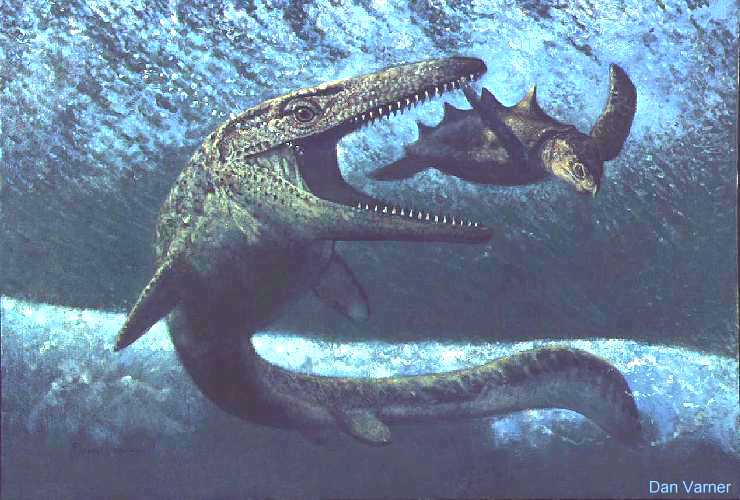
Clidastes propython:
A small mosasaur from the Upper Smoky Hill Chalk
Copyright © 2001-2012 by Mike Everhart
Created 01/14/01- Updated 08/24/2012
 |
Clidastes propython: A small mosasaur from the Upper Smoky Hill Chalk Copyright © 2001-2012 by Mike Everhart Created 01/14/01- Updated 08/24/2012 |
(Above: Drawing of the skeleton of Clidastes velox (propython) published in 1893 by S.W. Williston)
Clidastes mosasaurs were the smallest in size of the three major groups of mosasaurs found in the Western Interior Sea during the deposition of the Smoky Hill Chalk and are among the most primitive of the known mosasaurs. Maximum length was about 4 meters in the chalk and slightly larger in the Pierre Shale. Clidastes was much more common along the Gulf Coast than in the Western Interior Sea.
Clidastes liodontus is found in the lower section of the chalk (late Coniacian) and may actually be one of the first mosasaurs to enter the seaway (see Martin and Stewart, 1977) during the Turonian. Clidastes propython, however, arrived much later and is only found in the upper sections of the chalk. According to Williston and others, it may have preferred to live much closer to shore and thus would not be well represented in the mid-ocean area where the chalk was deposited.
This specimen was collected from Logan County in the Zone of Hesperornis (Stewart, 1990), 3 m above Hattin's (1982) Marker Unit 22 (early Campanian). It consists of most of the skull and about 25 vertebrae. Some of the specimen had eroded out before being discovered and was weathered into many fragments. Other parts were recovered in situ. The specimen has been donated to the Sternberg Museum of Natural History
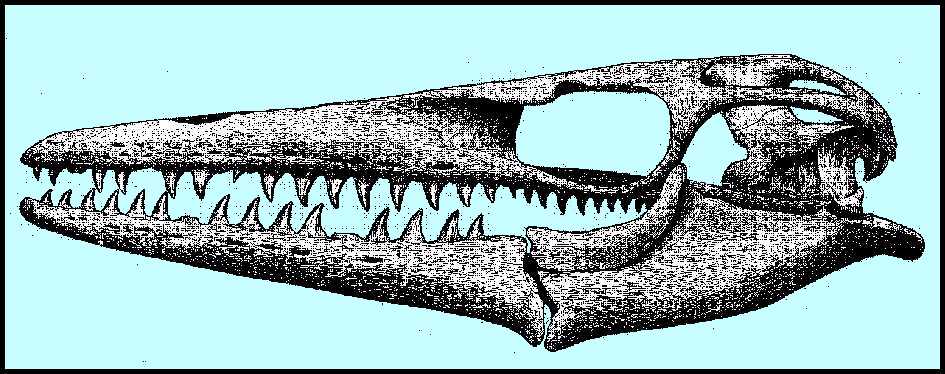
The skull of Clidastes propython adapted from Williston (1898).
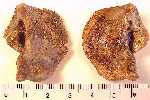 |
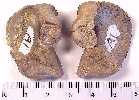 |
 |
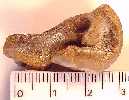 |
 |
Five views of the quadrates of Clidastes propython. (left to right) 1). Anterior aspects of the left and right quadrates. 2) Posterior view of the left and right quadrates. 3) A posterior view of the left quadrate laying against the right quadrate. 4) A posterior view of the right quadrate showing the stapedial pit. 5) A ventral view of the right quadrate showing the surface of the condyle that articulates with the lower jaw.
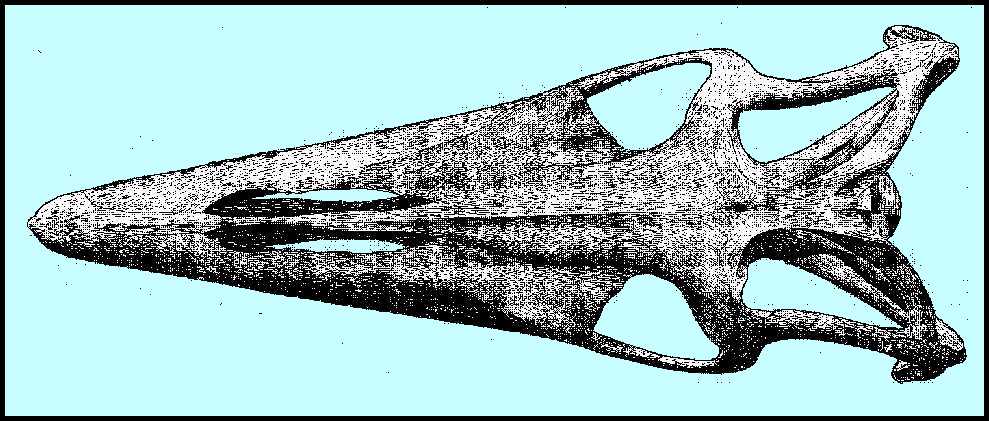
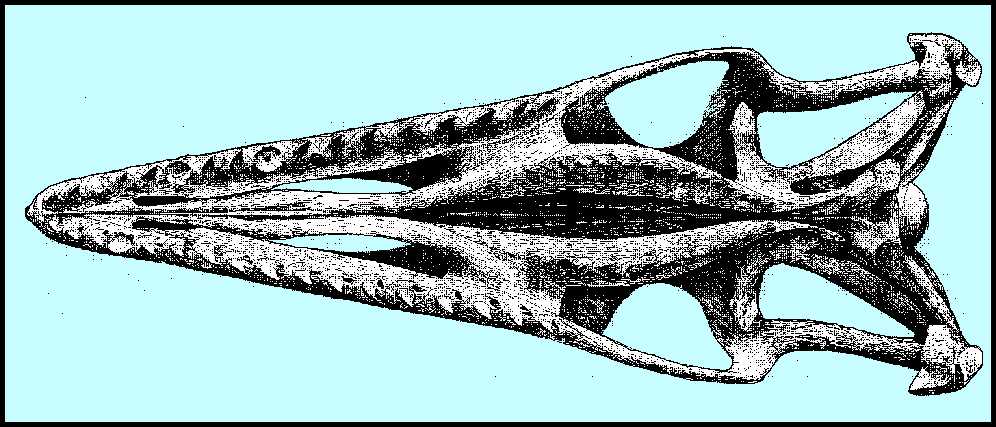
Additional reading about Clidastes:
Bell, G.L. Jr. 1997. A phylogenetic revision of North American and Adriatic Mosasauroidea. pp. 293-332 In Callaway J. M. and E. L Nicholls, (eds.), Ancient Marine Reptiles, Academic Press.
Bell, G.L. Jr. and Sheldon, M.A. 1986. Description of a very young mosasaur from Greene County, Alabama, Journal of the Alabama Academy of Science, Vol. 57, No. 2, pages 76-82.
Caldwell, M.W. and Diedrich, C.G. 2005. Remains of Clidastes Cope, 1868, an unexpected mosasaur in the upper Campanian of NW Germany. Netherlands Journal of Geosciences / Geologie en Mijnbouw, 84(3):213-220.
Cope, E.D. 1869. [Remarks on fossil reptiles, Clidastes propython, Polycotylus latipinnis, Ornithotarsus immanis.]. Proc. Amer. Philos. Soc. xi p. 117.
Cope, E.D. 1871. Synopsis of the extinct Batrachia and Reptilia of North America. Transactions American Philosophical Society, (n. s.) 14:1-252 + i-viii, 55 figs., 14 pl.
Cope, E.D. 1871. On some species of Pythonomorpha from the Cretaceous beds of Kansas and New Mexico. Proceedings of the American Philosophical Society 11(85):574-584.
Cope, E.D. 1872. [On a species of Clidastes and Plesiosaurus gulo Cope]. Proceedings of the Academy of Natural Sciences of Philadelphia 29:127-124. (meeting of May 28)
Cope, E.D. 1881. A new Clidastes from New Jersey. American Naturalist 15(7):587-588. (July issue, naming of Clidastes conodon)
Everhart, M.J., Everhart, P.A. and Bourdon, J. 1997 Earliest documented occurrence of the mosasaur, Clidastes liodontus, in the Smoky Hill Chalk (upper Cretaceous) of western Kansas. Kansas Acad. Sci. Trans. 16(Abstracts):14.
Everhart, M.J. 2001. Revisions to the Biostratigraphy of the Mosasauridae (Squamata) in the Smoky Hill Chalk Member of the Niobrara Chalk (Late Cretaceous) of Kansas. Kansas Acad. Sci. Trans 104(1-2):56-75.
Hattin, D.E. 1982. Stratigraphy and depositional environment of the Smoky Hill Chalk Member, Niobrara Chalk (Upper Cretaceous) of the type area, western Kansas. Kansas Geological Survey Bulletin 225, 108 pp.
Kiernan, C.R. 1992. Clidastes Cope, 1868 (Reptilia, Sauria): Proposed designation of Clidastes propython Cope, 1869 as the type species. Bull. Zool. Nomencl. 49 p. 137-139.
Kiernan, C.R. 2002. Stratigraphic distribution and habitat segregation of mosasaurs in the Upper Cretaceous of western and central Alabama, with an historical review of Alabama mosasaur discoveries. Journal of Vertebrate Paleontology 22(1):91-103.
Lindgren, J. and Siverson, M. 2004. The first record of the mosasaur Clidastes from Europe and its palaeogeographical implications. Acta Palaeontolographica Pol. 49(2):219-234.
Martin, L.D. and Stewart, J.D. 1977. The oldest (Turonian) mosasaurs from Kansas, Jour. Paleon., 51(5):973-975.
Ott, C.J., Behlke, A.D.B. and Kelly, D.K.. 2002. An unusually large specimen of Clidastes (Mosasauroidea) from the Niobrara Chalk of western Kansas. Kansas Academy of Science, Transactions (Abstracts) 21:32.
Russell, D.A. 1967. Systematics and morphology of American mosasaurs. Peabody
Museum of Natural History, Yale University, Bulletin 23.
Sheldon, M.A. 1995. Ontogeny, ecology and evolution of North American
Mosasaurids (Clidastes, Platecarpus and Tylosaurus):
Evidence from bone microstructure. Unpubl. dissertation. University of
Rochester. 183 pp.
Williston, S.W. 1893. Mosasaurs, Part II: Restoration of Clidastes, Kansas University Quarterly 2(2):83-84, 1 plate. (see Williston and Case 1892 for Part I).
Williston, S.W. 1898. Mosasaurs. The University Geological Survey of Kansas, Volume IV, Paleontology, Part V, pp. 81-347.
Williston, S.W. and Case, E.C. 1892. Kansas mosasaurs - Part I: Clidastes. Kansas University Quarterly 1:15-32, Pl. II-VI.
Wright, K.R. 1987. The mosasaur Clidastes: new specimens and new
problems. Jour. Alabama Acad. Sci. 58(3):99. (Abs.)
Wright, K.R., 1988. The first record of Clidastes liodontus (Squamata,
Mosasauridae) from the eastern United States, Jour. Vert. Paleon., 8(3):343-345.